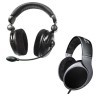- Qualcomm Launches Snapdragon 4 Gen 2 Mobile Platform
- AMD Launches Ryzen PRO 7000 Series Mobile & Desktop Platform
- Intel Launches Sleek Single-Slot Arc Pro A60 Workstation Graphics Card
- NVIDIA Announces Latest Ada Lovelace Additions: GeForce RTX 4060 Ti & RTX 4060
- Maxon Redshift With AMD Radeon GPU Rendering Support Now Available
Speedlink Medusa 5.1 and Sennheiser HD555

The choice between stereo and 5.1 headphones can be complicated, so we are taking a look at a popular sub-$150 offering of each type to see which one will come out on top. As we find out, the choice can make quite a big difference depending on what you will use your PC for most.
Page 4 – Performance Testing
I tested both headsets using a Creative X-fi as the sound card. Thus, I used the Creative Audio Console to adjust the audio output settings. The Medusas were always run with the output set to 5.1 speakers, while the HD555s were always run with the output set to 2/2.1 speakers. I used the Entertainment mode for music and movies, and the Game mode for games.
I listened to a variety of audio, from low-detail MP3s and MP4s to music CDs. I also watched a couple of DVD movies, and of course, spent some time with popular FPS games.
I’ll say right up front here that I’m more of a gamer than an audiophile, and obviously all of this is subjective. One thing that was true for both headsets was that sound was easily able to be heard some distance from the headset itself, so neither of these headsets is ideally suited to not bothering people sitting next to you. Neither of these headsets are noise canceling, but I never had a problem with hearing background noise during any of my testing.
I listened to a small variety of iTunes tracks and mp3s including the Smashing Pumpkins’ new single, Tarantula, [/shameless plug] as well as some Linkin Park, Metallica, Weezer, Great Big Sea, and Bob Marley.
Right off the bat I can easily see why people are recommending the Sennheisers. They sounded very clear and well defined across the entire audible range, and were able to deliver some nice, head-shaking bass. The Medusas, in my opinion, also sounded good, but compared to the Sennheisers they were noticeably more muffled, and mid-range details seemed to get lost in some of the more busy/heavy tracks.


With the Sennheisers, each sound was differentiated from the others in such a way that it was easy to visualize each string of a guitar getting struck as a chord was played, and each drum in the set as it was hit. The fact that my ears felt like they were in open air helped to make me feel like I was right in the middle of the recording studio, and I commend the physical design of the Sennheiser HD line.
Compared to the HD555s, it’s obvious that the Medusas didn’t quite measure up – but they still sounded good, and I don’t think that anyone other than a serious audiophile would have any problem with the way these cans sound – at least I don’t. It’s like the difference between being in the middle of the recording studio vs. being outside the glass. The in-line remote allowed for a little fine-tuning, which in some cases gave a small improvement, but I was never able to get as clean a sound as with the HD555s.
I listened to a variety of music by the Smashing Pumpkins, Five For Fighting, the Dropkick Murpheys, Linkin Park, and Cold Play.
This is going to be a ditto of the low-detail section. The only surprise was ‘100 Years’ by Five for Fighting, which for some reason sounded clearer and more defined on the Medusas. Everywhere else, the HD555s sounded better – but the Medusas also sounded good.
I chose two of the better action movies I’ve seen in the somewhat recent past and tried to pick out scenes where the difference between the two headsets was most notably different.
Batman Begins

|
There were a handful of scenes in this movie worth mentioning, but I’ll try to be brief.
The scenes where Bruce is declared ‘ready to lead these men’ contains a bit of spooky off-screen dialogue by Liam Neeson, which the Medusas (unsurprisingly) reproduced with a more three-dimensional feel, as Neeson seemed to move around the audience.
Where the HD555’s made it sound like he moved from left to right, getting slightly louder or quieter, the Medusas did a better job of making it seem like Neeson was actually moving around the room. The following climatic fight scene was actually a little disappointing with both headsets, (mainly because the explosions were much too quiet) but I believe that this is a problem with the mastering of the movie.
Other scenes involving swirling bats and a car chase also generally sounded better with 5.1 effects – the Medusas made it sound like there were more bats (in more directions), the motion and placement of cars on screen was more audible, and the quality of the Medusas was certainly good enough for me. While the HD555s sounded cleaner and tended to define the consonants in speech a little better, I have to say that their advantage in accuracy was not large enough to make me prefer them to the Medusas – the surround effects were a greater benefit.
The Incredibles

|
I found this movie to be an excellent choice for testing due to the huge amount of surround sound detail. I used chapter 9 (mainly) for the test. This chapter starts with a quick mission briefing in an air plane, followed by an air deployment to a tropical island, a few shots of the hero running around huffing his breath and ruffling foliage, ending with an intense battle with a huge robot. I watched this chapter completely 4 times, alternating between headsets.
I honestly couldn’t tell which headset had the better speakers while watching this movie – both headsets sounded great. From the soft ruffling foliage to the crushing impacts of the battle, the sound was very clean. One thing I noticed with the Medusas was that the center channel was overpowered, but when I turned it down to ~7 on the inline remote (leaving the other channels at 10) everything was fantastic.
Unfortunately for the HD555’s, since I didn’t notice a difference in the general quality of the sound, the only other difference was the number of speakers. Because of the more accurate 3D placement with the Medusas, I definitely preferred them here. There was a big difference in the amount of motion into and out of the screen (not surprisingly).
A perfect example would be when the robot first starts to roll – with the HD555s, it simply moves from right to left and back. With the Medusas, you can clearly hear the robot roll away and to the left, and then come back forward right at your face. This is even noticeable when characters walk of screen – you can tell if they’re coming toward you or moving away.
I focused on first-person shooters here because the benefits of accurate surround sound can have a large impact on the player’s success in the game, and thus these games are the main fodder of marketing people trying to sell you a 5.1 headset.
Quake 4

|
I never really got into this game after playing through it once, so I didn’t have a large selection of save-games to choose from, but the first few missions of the game have a decent variety of audio effects from running around trenches in a full-scale battle to sneaking around dark subterranean tunnels.
The Sennheiser HD555’s produced noticeably clearer sound in this game. The dialogue was cleaner, and the gunfire sounded more complex with the HD555s.
There was also very little noticeable difference between the headsets with regard to surround sound. You’d think that the difference would be obvious during the very first part of the game as rockets and lasers are constantly firing right over your head – supposedly by large forces on either side of you. Unfortunately, it seems like the actual sources of these sounds are lumped into two locations, one far to the left and one far to the right, so you never get a sense of three dimensional location.
Going underground didn’t result in much improvement – the Medusas seemed more accurate when things were behind me, but otherwise didn’t help much. I felt that, for the price, the HD555s were the way to go in this game.
F.E.A.R.

|
I love this game, and at the expense of face-time with Quake 4, have played through it multiple times, and have save points for most of my favorite portions. I spent a few hours playing through large-scale confrontations like ‘LZ is Hot’ and the end portion of ‘Heavy Resistance’ as well as other choice excerpts.
Again, the DH555s were slightly cleaner and more defined, but the Medusas really started to make a difference in this game, to the point that I think some sounds were lost completely with a 2.1 setup. With the Sennheiser HD555s, an enemy that was completely silent occasionally flanked me, and I couldn’t always tell where to aim if I couldn’t see my enemies.
With the Medusas, I was never flanked unwillingly, and it seemed like there were more audio cues – more footsteps, more rustling clothing, etc. and it was all very well placed. I found myself turning to aim at enemies as they emerged from cover and was often impressed with how little I had to think to aim. The Medusas were definitely preferable to me in this game.
Half Life 2 – Episode 1

|
While I’ve played through HL2, I hadn’t gotten very far in Episode 1, so I played a while with the Sennheisers and later switched to the Medusas, without replaying anything (unless I died) and having zero advance knowledge of what was going to happen.
The Sennheisers sounded fine, which shouldn’t be any surprise, however I didn’t notice much difference when changing to the Medusas – the slightly increased muffled-ness of the sound wasn’t nearly as pronounced – which was a very pleasant surprise.
The difference in surround effects was also very surprising. There’s a part of the game where you’re stuck underground in a large, dark space and you have to follow a power line to a PSU box in order to power up an elevator. There are a few red emergency flares lying around.
Now, anyone who’s played a video game before would know (as I did) that all hell was about to break loose and that enemies would soon be swarming out of nowhere just as my (poorly placed) flares died out and I’d be left with only my flashlight and a prescient NPC auto-turret (with pleasantly-fitted jeans) – and my ears – to indicate where I should unload.
Sure enough, here they came and it was pitch black. This was the first time I became frustrated with the HD555s. The stereo sound was not enough to give me a good idea where things were, and I found myself ‘shaking my head’ with mouse-look and relying too much on my flashlight. Alex (a.k.a. ‘Jeans’) and I got smacked around a lot before reaching the elevator.
Later, when I switched to the Medusas, the first thing I noticed was that the center channel seemed over-powered, but setting it to 7 on the in-line remote (leaving the other settings at 10) fixed that problem. We were out of zombie-land and dealing with the usual human law enforcement enemies now. There were several instances where unseen enemies were moving in off-screen and I had to guess where they were and react accordingly.
I was very, very impressed with the Medusas because not only did I never guess wrong, taking out many enemies before they were able to fire at me, but being able to hear where they were and where they were going also gave cues as to the shape of hallways – it’s nice to know where you need to go to meet an enemy without thinking about it. I was very, very happy with the Medusas in this game.
Little changes with CS:Source. The gunfire sounds more detailed with the HD555s, but the Medusas have a big advantage when it comes to hearing movement in the tunnels to B in Dust2 (for example), or being able to actually hit someone behind one of those wooden doors, or simply knowing if you have time to pull out a flash-bang, and where it would best be placed.
|
|
Support our efforts! With ad revenue at an all-time low for written websites, we're relying more than ever on reader support to help us continue putting so much effort into this type of content. You can support us by becoming a Patron, or by using our Amazon shopping affiliate links listed through our articles. Thanks for your support!




